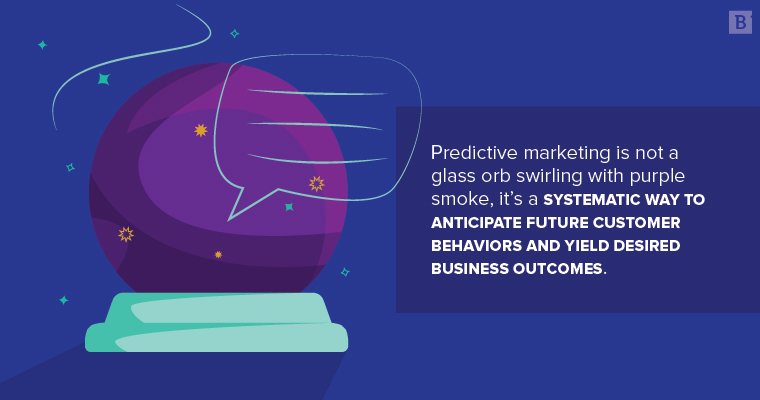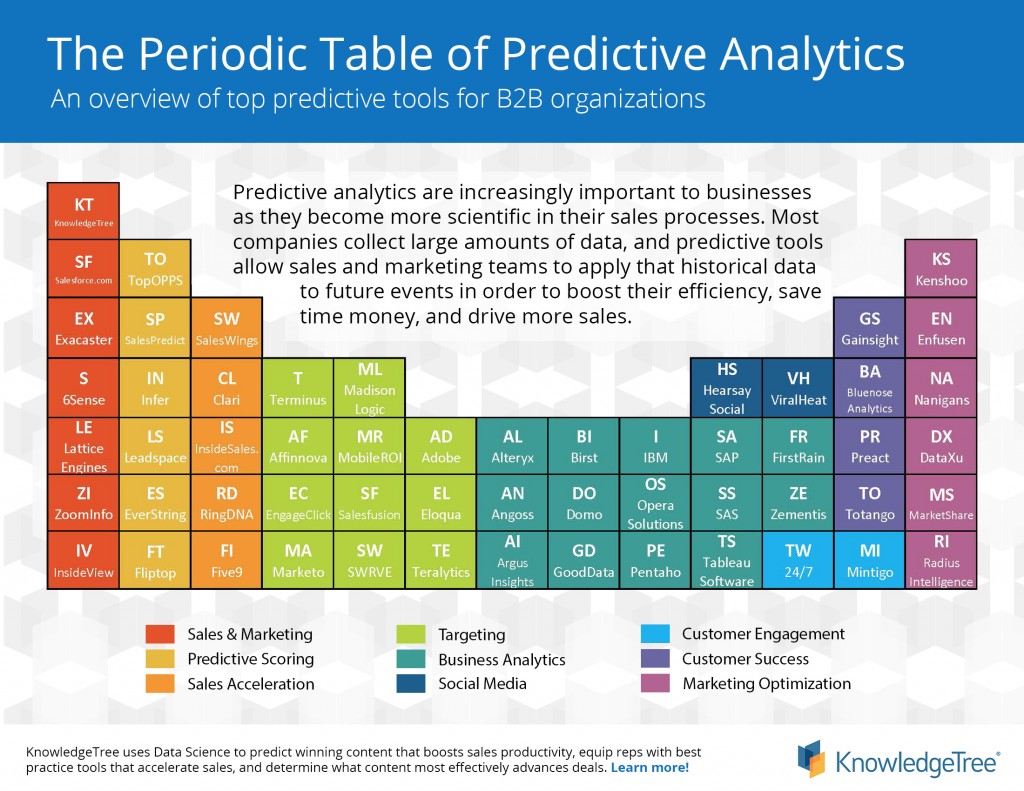Wouldn’t it be nice to know which email contact lists are worth buying before you buy them? What about speeding up your sales cycle by empowering sales reps to work more efficiently and more productively? That’s what predictive technologies can do for your organization.
It’s not a glass orb swirling with purple smoke. Predictive marketing is the strategic use of existing customer datasets to identify patterns and anticipate future customer behaviors, sales trends and marketing outcomes. Organizations that leverage predictive marketing strategies have more opportunities to appeal to their desired audience.
Here, we’ll unpack all things predictive marketing, diving into what it is, real-world examples and a few best practices to consider.
Why is Predictive Marketing Important in Today’s Marketplace?
Gathering customer data to improve future marketing efforts is not a new practice, but modern strategies use machine learning and artificial intelligence algorithms to process previously unimaginable volumes of information. Today, marketers can take advantage of synthetic data to develop predictive models, enrich leads and analyze program performance.
You’re probably most familiar with this use case on E-commerce sites. When you put a product in your Amazon cart, a predictive model analyzes your purchase history against anonymized records of shoppers with similar preferences and suggests another product that might interest you. Modified slightly, the tactic can be extremely useful in a B2B setting as well.
Marketers can use predictive data science across all channels, giving them more opportunities to put a tailored message in front of an interested audience. Predictive technologies integrate with email, social, web and phone channels to deploy strategic messaging at an optimal rate.

How Does Predictive Marketing Analytics Work?
Predictive technologies can identify which contact lists are worth buying, based on a comparison of the contacts within those lists and customer data your organization has previously gathered. Likewise, predictive marketing analytics tools can expand your organization’s existing leads with data enrichment services. Together, these solutions give sales representatives the power to have more productive conversations with leads, with less time needed to develop the relationship.
Uniquely, predictive models can benefit every stage within the buying pipeline. Marketing stakeholders can develop an omnichannel buyer’s journey — creating text, visual and interactive content — with the trust that each step will be consistent. Whether a prospect interacts with your organization through a landing page, newsletter, white paper, chatbot or phone call, predictive solutions support engagement with tailored interactions.

Predictive marketing can take many forms, and it is not limited to inbound lead generation or cold call tactics. Analytic models can increase an existing lead’s total spend.
Examples of Predictive Marketing
No matter what your marketing goals are, there’s a predictive modeling solution that can improve your chances of success. Here are three predictive marketing examples to inspire you:
Subscribe to
The Content Marketer
Get weekly insights, advice and opinions about all things digital marketing.
Thank you for subscribing to The Content Marketer!
Anticipate Customer Behavior
When Amazon suggests a new item to you, the platform is attempting to predict behavior. If you purchase a bagless vacuum cleaner from the site, you’ll likely be prompted to add a replacement air filter to your cart. In the B2B space, algorithms can provide similar functionality. For instance, if a customer buys a set of training videos from an eLearning company, predictive software might prompt the salesperson to suggest a related course or practice assessment.

Keep in mind that this type of prediction is only as useful as the input data. Using generalized datasets may not provide the full picture until you integrate them with your sales team’s proprietary information.
Targeted Lead Qualification
Let’s say you have a set of historical data describing all of the clients in your database as well as their buying habits. A predictive algorithm can compare the described behaviors with another data set and pinpoint leads that show similarities to your previously successful conversions. This supports the sales team by allowing them to prioritize leads with a higher likelihood of taking action.
This type of model can be deployed throughout the sales funnel, identifying which site visitors are likely to download an eBook, which eBook readers are most likely to talk to a salesperson and which leads are most likely to convert to repeat customers.
Direct Customers to Tailored Content
Predictive models support content marketing strategies by intelligently displaying tailored content to targeted audiences. 84% of organizations plan to spend the same or more on their content marketing budgets in the future. Analytics powered by machine learning can optimize this spending by improving engagement metrics for each piece of content produced.
Rather than publishing content to a faceless audience, predictive models anticipate reader interests as well as their likelihood to take an action, then deliver content designed to appeal to that specific segment of the audience.
Popular Predictive Marketing Research Tools
Depending on the scale of your organization, you may have the resources to develop a tailored model that supports your unique goals. However, the majority of organizations leverage analytics software deployed over the cloud. These tools are among the most popular:
SalesForce Marketing Cloud
Within its offerings, SalesForce provides a number of software as a service marketing solutions powered by AI. The platform gives marketers the ability to create 1-to-1 consumer journeys, analyze sales data and automate marketing tasks.
Everstring
The predictive analytics solutions from Everstring are designed to support marketing and sales teams as they build pipelines. Specifically, the software supports audience identification and demand generation goals.
IBM Predictive Analytics
The analytics offerings from IBM are extremely powerful. In addition to a library of machine-learning algorithms and analysis programs, IBM supports open-source integrations. Your internal data scientists can leverage the platform to support any analytic project written in R or Python.
Radius Intelligence
Designed for B2B teams, the data analytics solutions from Radius Intelligence support lead generation with data health checks, data validation services and real-time data enrichment. Together, these solutions augment inbound leads and deepen market intelligence.
Predictive Marketing Best Practices
Though each strategy is unique, there are 4 foundational elements that are consistent among successful implementations of predictive technology:

#1) Understand How Predictive Marketing Supports Your Goals
Predictive models can benefit organizations in any industry, but each strategy must be defined by unique challenges. The SalesForce State of Sales report found that account-based sales teams are 2.4 times more likely to seek out predictive technology. If an organization’s goal is quantifiable, there’s a good chance the company can benefit from a predictive model.
#2) Assess Your Model
Machine learning algorithms cannot read the future; they are fallible. The models employed by your organization should be reviewed and maintained by an expert. Likewise, model output should be interpreted by an experienced stakeholder.
#3) Give Your Strategy Time
Predictive modeling recommendations require a ramp-up period before they reach their full potential to maximize ROI. Research from Salesforce revealed that the rate of orders influenced by predictive intelligence recommendations increased from 11.47% to 34.71% over 36 months, on average.
#4) Integrate Your Strategy With Sales
Predictive marketing conversations should include stakeholders from the marketing and sales departments. Strategic models can benefit lead generation, cross-selling and up-selling objectives.
Gain Data-Driven Insights with Brafton
Data-driven marketing technologies can bring amazing advantages to marketing teams of any scale. Utilizing massive datasets and sophisticated machine learning algorithms, predictive models identify leads, predict audience preferences, support marketing automation goals and drive customer engagement.
You don’t need a crystal ball to predict the future — use predictive modeling tools to leverage marketing data and drive sales.
Editor’s Note: Updated February 2024.





